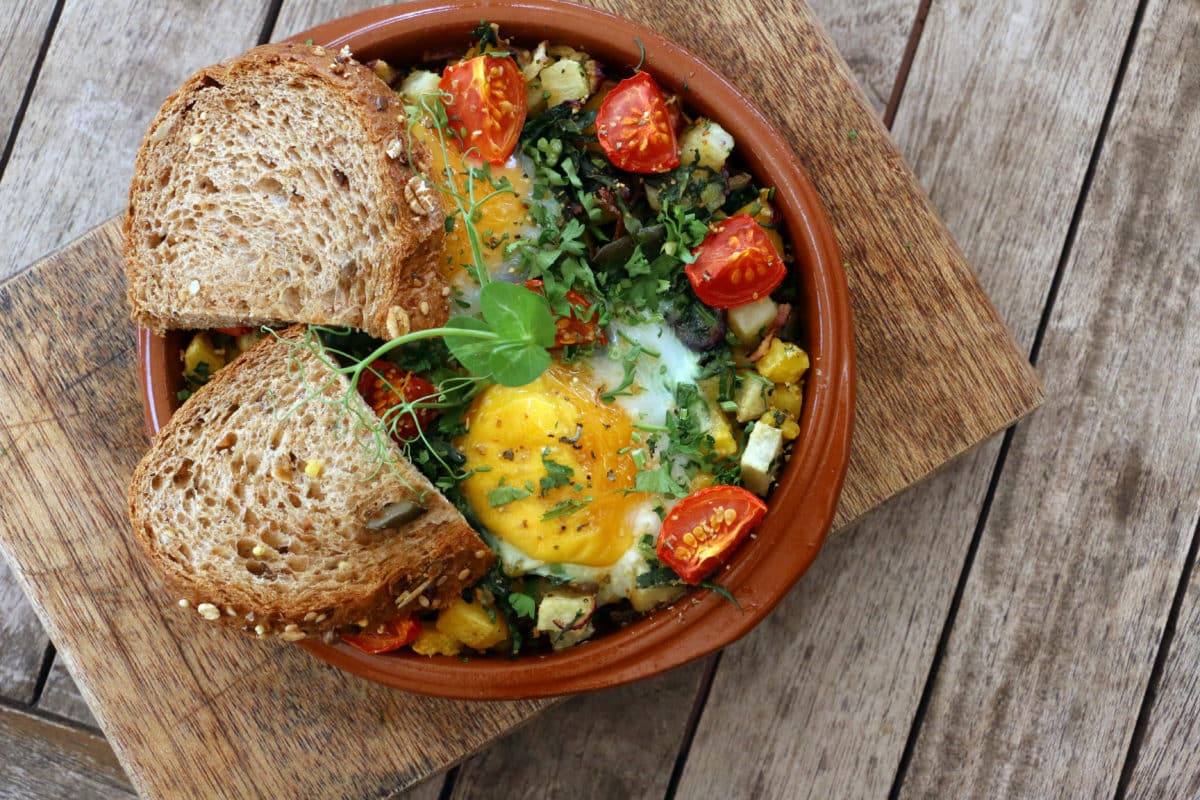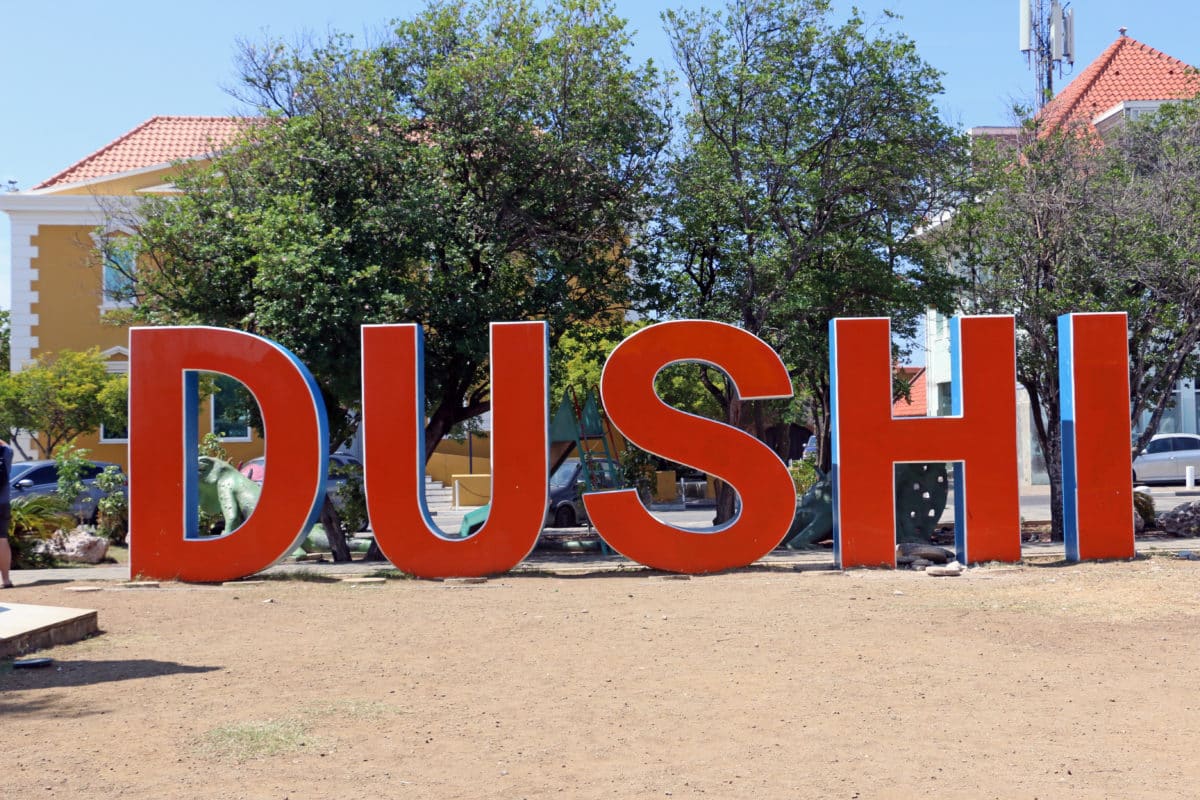The veranda of Hofi Cas Cora, Curaçao’s first farm-to-table restaurant, looks out over the restaurant’s fields, but for the moment my eyes are drawn to a rather sizable lizard which has surreptitiously worked its way into part of the restaurant. It flits in and out of the shade, taking refuge first under a chair and then under an unoccupied table. As our server walks by, it jets back outside in search of something tasty. Meanwhile my own food has arrived, a hash made from white sweet potato which is covered with a farm-fresh egg and tender, curling pea tendrils. Everything in the hash was grown or raised in the field I am surveying from my shaded seat. It is beautiful, simple, and delicious.

Since arriving on Curaçao I’ve felt like the lizard that captured my attention. I’ve sought relief from the dry, windy heat in the shade of enormous gnarled mesquite trees where I’ve eaten vegetable soup thickened with the pulp of cactus and served with bread baked in an outdoor oven made from bricks transported to the island by slave ships. I’ve walked down the cobbled and paved streets of the capital of Willemstad to visit a floating vegetable market, where boats pull right up to the pavement in order to sell their wares. I’ve eaten conch while looking out over some of the cleanest, bluest oceans I’ve ever witnessed, and I’ve walked across darkened moon-lit streets to eat Caribbean-inspired tapas, and to drink cocktails at Luke’s Cocktailbar where Luke, the bartender/owner, has just as much fun working as his customers have drinking.

Curaçao (pronounced Cur-ah-sow) is different from the other Caribbean islands you may have been to. It sits just 35 miles off the coast of Venezuela, a part of the “ABC” island chain that makes up the Lesser Antilles – Aruba, Curaçao, and Bonaire. As one of the southernmost islands in the Caribbean it sits outside of the hurricane zone, insulated from the severe storms that occasionally pummel the wider Caribbean. Unlike other Caribbean islands it’s also quite dry. While the island’s coast is lush with greenery, the interior is studded primarily with cactus, mesquite, and other plants which require less moisture. As a result Curaçao, which was originally discovered by the Spanish but has been in possession of the Dutch since 1634, was less of an agricultural hub than islands like Jamaica and the U.S. Virgin Island of St. Croix, and used slavery to produce crops like corn and sorghum as opposed to sugar cane.
The capital city of Willemstad, a UNESCO World Heritage City known for its colorful buildings and floating pontoon bridge, became a trading port for the Dutch, Spanish, French, British, and Portuguese as a result of its location, agriculture, and history of slave trade. Today, Curaçao is a vibrant and multicultural island. Many of the island’s inhabitants, including descendants of victims of the slave trade, speak a native language called Papiamentu, but English, Dutch, and Spanish are also official languages. It’s an island where history and culture, both positive and lamentable, have blended together to form something unique.
Caribbean cuisine is often strongly influenced by either native plants or animals or those imported during the 1600 and 1700s. Dishes made with polenta, beef, fish, and breadfruit are varied and plentiful across disparate islands, and visitors to Curaçao may recognize foods from the islands of St. Croix or Jamaica. However, Curaçao’s modern internationality brings a breadth of dining options that more closely resemble those of a large city. While hotels and resorts serve the typical assortment of vacation foods, ranging from hamburgers and imported steaks to fresh-caught local seafood, it’s not difficult to find French, Japanese, Dutch, BBQ, and other cuisines which reflect the breadth of the travelers who make Curaçao a vacation destination.
Because Curaçao was a Dutch colony and remains a part of the Netherlands, it’s worth seeking out restaurants that serve food influenced by the Dutch. The Restaurant & Cafe Gouveneur de Roueville serves courses like rich karni stoba, an Antillean-style braised beef stew redolent with warm spices, and kabritu curry made with goat gently braised in coconut milk. Restaurants like the aforementioned Hofi Cas Cora serve food which takes advantage of both seasonality and locality.
For a true taste of what’s local, the Marsche Bieuw, a covered food hall frequented primarily by locals, may be the best spot on the island. Filled with large stalls where food is cooked over wood and coal, chicken, beef, fish, and vegetables are fried, baked and stewed into everyday dishes that provide a sense of place and belonging with each bite.

Travel across Curaçao and you’ll see the word “dushi” prominently emblazoned across the island. It roughly translates to “sweetie” but can also mean something along the lines of “my love,” and it’s as much a word as it is a concept. The food on Curaçao – whether it’s from a humble stand selling snacks or an upscale restaurant serving international cuisine on white linen – is “dushi.” It’s fresh, it’s lively, and it speaks to a deep and complicated history and a modernity reflective of international inclusivity. ![]()
